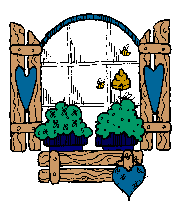
 Herbs and spices are accents that enhance the flavor of foods; they should not obscure the flavor. Do experiment with herbs and spices but don't use too many kinds at once. Begin by adding 1/4 teaspoon for every four servings, taste and, if desired, add more. Don't overdo the magic; too much will destroy the flavor of the food.
Herbs and spices are accents that enhance the flavor of foods; they should not obscure the flavor. Do experiment with herbs and spices but don't use too many kinds at once. Begin by adding 1/4 teaspoon for every four servings, taste and, if desired, add more. Don't overdo the magic; too much will destroy the flavor of the food.An herb is the leafy part of a temperate zone, nonwoody plant. Examples: parsley, sage, rosemary and thyme.
A spice is a part of an aromatic plant (dried seeds, stem, bud, fruit, flower, bark or root), usually of tropical origin. Examples: allspice, cinnamon, clove and nutmeg.
Don't be confused by definition--the terms are often used interchangeably. It is more important to know how to use and store herbs and spices.
 Fresh Herbs: Quick-cooking dishes such as sauteed fillets of fish and chicken taste best when seasoned with fresh herbs such as basil, oregano, tarragon and parsley. Because some fresh herbs, such as basil, chervil, chive, mint, oregano, parsley and tarragon are low in oil (which imparts flavor and fragrance), the fresh forms are preferred. These herbs are not good for prolonged cooking, but you can extract their flavor over a long period, such as when using them to flavor oils or vinegars.
Fresh Herbs: Quick-cooking dishes such as sauteed fillets of fish and chicken taste best when seasoned with fresh herbs such as basil, oregano, tarragon and parsley. Because some fresh herbs, such as basil, chervil, chive, mint, oregano, parsley and tarragon are low in oil (which imparts flavor and fragrance), the fresh forms are preferred. These herbs are not good for prolonged cooking, but you can extract their flavor over a long period, such as when using them to flavor oils or vinegars.Storage of Fresh Herbs: Wash well; place in containers in the refrigerator and snip with kitchen shears as needed. These will last in the refrigerator about a week. To stretch the life of fresh herbs; set bunches in jars with an inch or two of water, cover with plastic wrap and refrigerate.
If you have purchased too many fresh herbs to use immediately, just rinse them in several changes of water and pat dry with paper towels. Seal small, usable amounts in freezer bags, foil or plastic wrap. Label and date each small packet and freeze.
 Dried Herbs: Fresh herbs aren't as necessary in dishes such as stews and sauces that simmer for an hour or more. For these dishes, dried herbs, expecially clove, thyme and bay leaf, are fine. The long cooking time allows dried herbs to absorb moisture and increase in flavor.
Dried Herbs: Fresh herbs aren't as necessary in dishes such as stews and sauces that simmer for an hour or more. For these dishes, dried herbs, expecially clove, thyme and bay leaf, are fine. The long cooking time allows dried herbs to absorb moisture and increase in flavor.Reconstitute dried herbs before adding them to foods served cold by soaking them for at least 10 minutes in the liquid(wine,stock, milk, lemon juice, oil or vinegar) that will be added to the foods.
Ground Spices impart their flavor immediately. They should be added to foods about 15 minutes before the end of cooking time whenever possible.
Whole spices are best used in long-simmering foods such as soups and stews. Wrap whole spices in cheesecloth or place in a tea ball or, as in the case of cloves, stick them into an onion. The whole spices can then be easily removed after cooking.
Seeds should be toasted before being added to foods.
Storage of Dried Herbs and Spices: Herbs and spices should be fresh tasting and fragrant. If you're unsure if the herb or spice on your shelf is good, give it the sniff test to see if it has its characteristic aroma. Then taste a pinch. If the flavor and the aroma don't come through, the herb or spice certainly can't do much for the food you're preparing, so toss it out! Under favorable condition, dried herbs will last six months to a year; ground spices will remain fresh up to a year. Whole spices will remain fresh indefinitely.
Do not store your herbs and spices over the stove. Although handy, the hot/steamy environment destroys the flavor, encourages caking, causes color changes and encouragaes infestation. Do use clean airtight, non-absorbent containers and keep in a cool dark area. In hot climates (or in summer) it is practical to store the capsicum spices (ground red pepper, chili powder and paprika) in the refrigerator to guard against infestation. Be sure to date all spice and dried herb containers.

